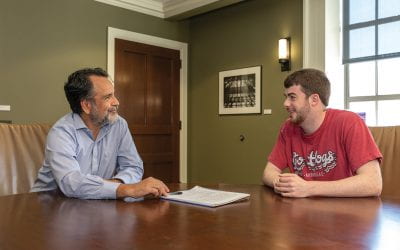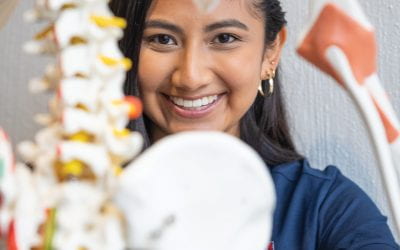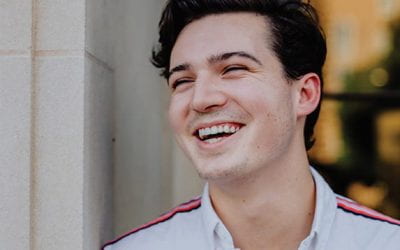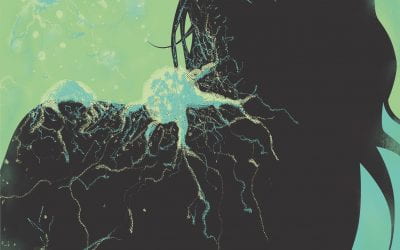
By Hiba Tahir
Photos by Hiba Tahir and Chieko Hara
With normalcy beginning to return after months spent working from home, mostly in sweatpants, many are itching to refresh their wardrobes. Before you whip out your card for the latest trends, though, consider this: Less than 1% of apparel products are recycled worldwide, and 70% of American clothing is discarded after only seven to eight wears.
When senior Sara Jayne Wilson, an apparel and merchandising major from Alma, stumbled across these facts early in her research, she decided to focus in on sustainability for her final project. “Deciding what skirt is going to be trendy next season doesn’t really have a human value to me,” Wilson explained. “I wanted to do something I enjoy, but I also know how important it is to feel that what you’re doing is valuable. How can I help people? How can I improve upon something? How can I make someone’s day better? This is the way that I feel like I can do that.”
“Deciding what skirt is going to be trendy next season doesn’t really have a human value to me.”

For much of her time in college, Wilson worked for a local clothing consignment store, where items that didn’t sell within three months would be sent to one of three local shelters. One such item — an extravagant jacquard brocade coat — caught her eye.
“It was in a bin on its way to one of those three places, just in the back of our store,” Wilson remembers. The garment’s potential made her pause.
“It was just so beautiful,” she said.
And so she used the discarded coat to create a couture two-piece outfit. The process, known as upcycling, involves reusing old materials to make a new product of higher value, and it’s become increasingly popular among fashion enthusiasts who are concerned by the dire impact fast fashion has on the planet. And what an impact: An article in the New York Times cites that nearly three-fifths of all clothing ends up in incinerators or landfills within a year of being produced, more than 8% of global greenhouse-gas emissions are produced by the apparel and footwear industries and around 20 to 25% of globally-produced chemical compounds are used in the textile-finishing industry.
Wilson says she began her project with the question, “What do we do with our clothes when we no longer use them?”
“I typically don’t find myself throwing things away unless they’re in really poor shape, but a lot of people do throw things away,” she explained. The fashion industry doesn’t help because it tends to push consumers to buy more sustainable products to be more sustainable. “Yes, if you’re going to buy something, you should buy something you know is Fair Trade Certified or uses natural fibers, but that’s still kind of perpetuating the ‘more’ mindset of consuming,” Wilson said. “If you can use what you’ve already got, that’s better.”
Originally, she wanted to create a couture collection comprised of ten or more upcycled items, but her thesis committee dissuaded her, encouraging her to focus in on one item. That focus allowed her the time to create something truly exceptional: her two-piece outfit, which she called the “Conscious Couture Look.”
 “With upcycling, you don’t know what’s going to come out until you’re in the midst of it,” she said. “You have to play around.” Wilson said her inspiration for the design came from the knowledge that upcycling often involves “piecing together smaller scraps or saved bits of fabric to create a swath of yardage to serve as the basis for a garment.”
“With upcycling, you don’t know what’s going to come out until you’re in the midst of it,” she said. “You have to play around.” Wilson said her inspiration for the design came from the knowledge that upcycling often involves “piecing together smaller scraps or saved bits of fabric to create a swath of yardage to serve as the basis for a garment.”
Instead of the typical scraps, the Conscious Couture Look was created using just one deconstructed coat, but Wilson explained in her thesis that she tried to “mimic a pieced-together look” by cutting the coat up into several pieces. The simple lines of the skirt and bustier top showcase the coat’s beautiful jacquard fabric, but Wilson challenged herself to use every part—including the navy inner lining, which she transformed into bust cups and borders cut to flatter and hug the body.
“Each garment also features a pleated texture, on the bust cups of the bustier and the center front panel of the skirt, which add interest and dimension to otherwise rigid garments,” Wilson explained in her thesis. When she ran out of lining fabric, she had to drop the center pleat in front of the skirt, an unexpected hurdle that ultimately served her vision.
Wilson took great care to transform a coat headed to a trashbag into an outfit with couture appeal. “I took steps along the way to make it as high-end as I could,” she said. “The creative vision was to go from something that really didn’t have much of a bright future into something that was prized, and aesthetically pleasing, and more desired.”
For the research portion of the project, Wilson catalogued local secondhand stores in an effort to encourage sustainable shopping practices by consumers in Northwest Arkansas. After graduation, she assumed a managerial position at one such location— where she worked for much of her time in college, and where she stumbled across the coat. “It’s an over twenty-year-old business, and there’s been slow growth, but I feel like this is the time to capitalize on all the potential it has,” she said.
Wilson received an Honors College Research Grant in support of her project.
More Field Notes
Goodwill Job Hunting
By Katie Wilson PowellPhotos by Chieko Hara For Jimmy Donlon, a senior marketing and management major and Honors College fellow, serving the community has meant being a part of the community throughout his entire life. Donlon’s father, a physician, founded a network...
Love Your Back? Take a Break!
By Hiba TahirPhotos by Russell Cothren Sitting down may be hazardous to your health. Those who spend several hours a day in seated positions — which, in the last year or two, is most of us, thanks to the COVID-19 pandemic — may find themselves struggling with lower...
Power Plays
By Kendall CurleePhotos by Beau Burris“The grand scale of both Versailles and D.C., built to awe and impress, gets the job done.”Washington, D.C. Satellite imagery © Google Earth Versailles, France. Satellite imagery © Google Earth Beau Burris has been obsessed with...
The Monster She Made
Image: Leigh Caruthers PrasselBy Hiba TahirPhotos by Chieko HaraWhen a family member was diagnosed with Ewing’s sarcoma, a rare form of bone cancer, Morgan Walker, an English major from Prairie Grove, saw many similarities between the grim prognosis and the plight of...
Prime Time for Gene Editing
Mary Jia searches for bacteria colonies that contain the plasmid needed to construct the gene-editing tool she’s designingBy Katie Wilson PowellPhotos by Chieko Hara Mary Jia, a biomedical engineering junior and Bodenhamer Fellow, has had her sights set on CRISPR...






